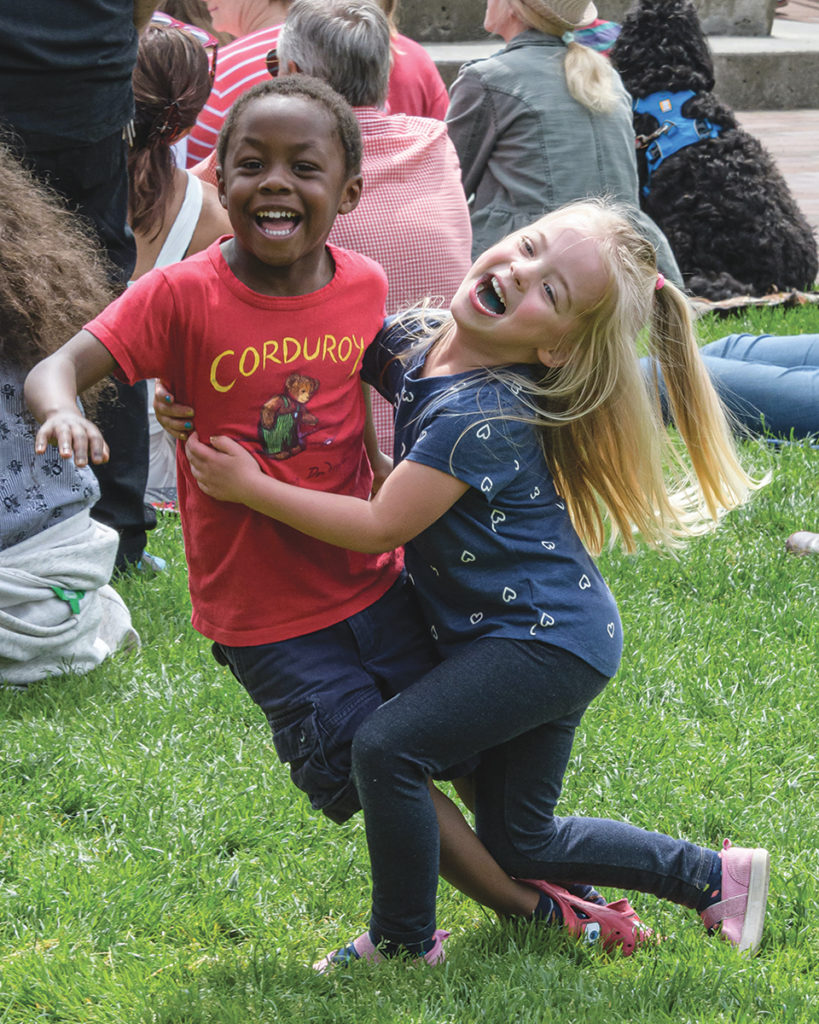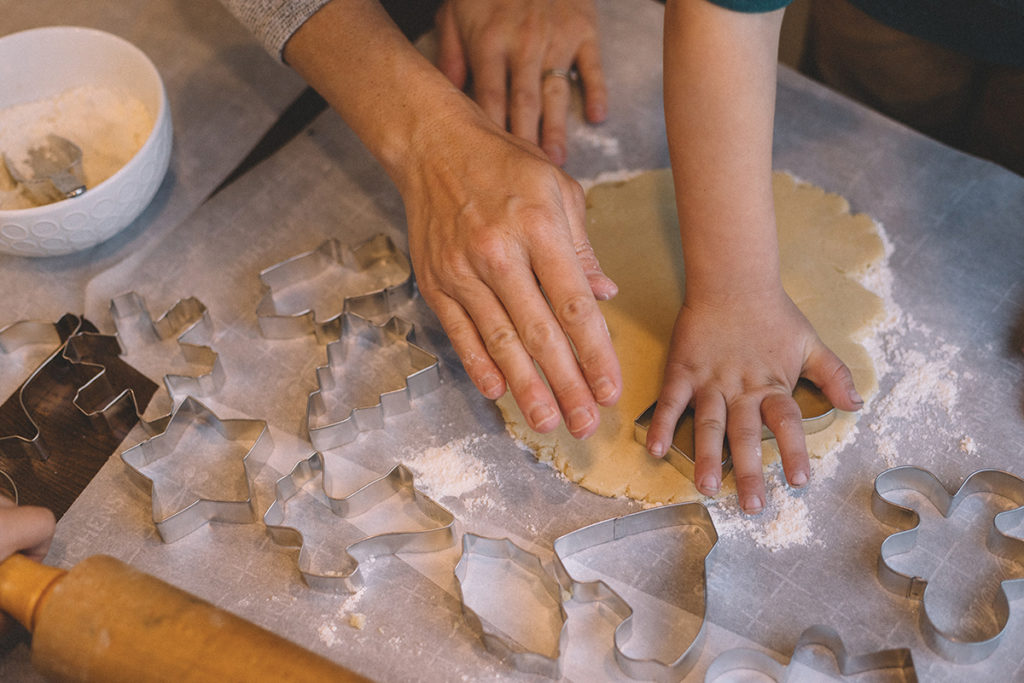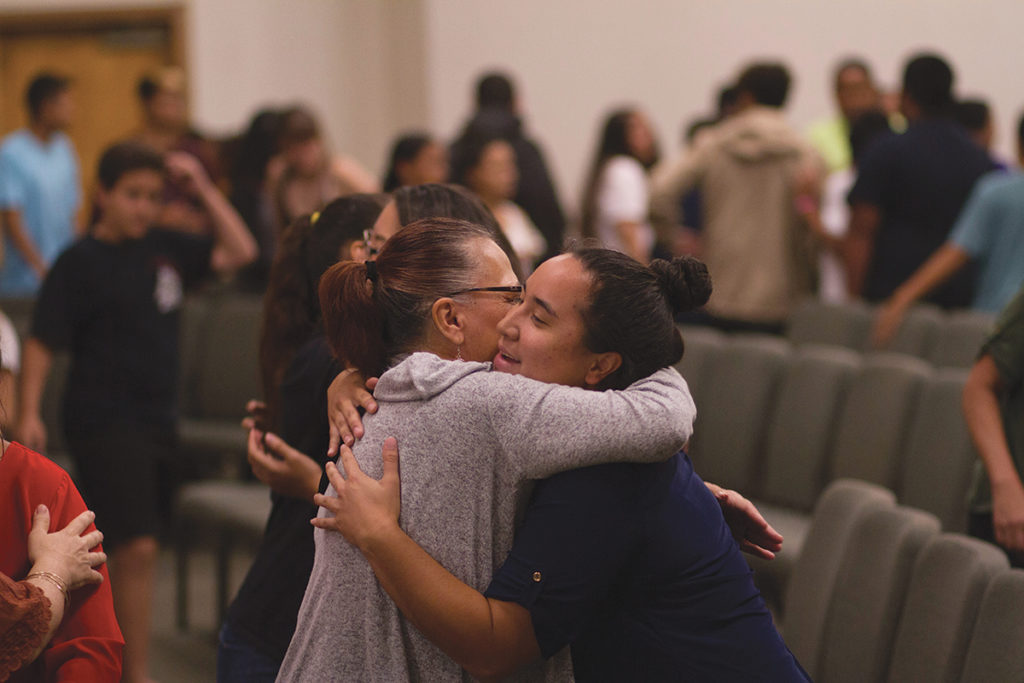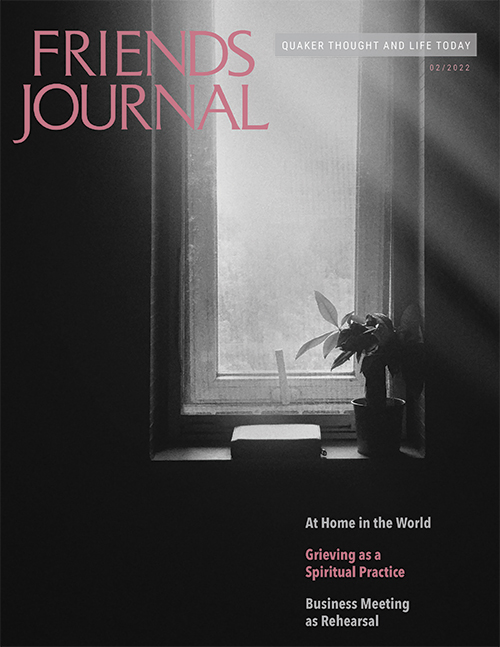Those of us who are under 60 in the Religious Society of Friends often get asked how meetings can attract more young people to Quakerism. There are many answers to this question: none of them definitive, but we are moved to share our experience as Quaker parents who would like to raise the next generation of Quaker youth—and would like to feel that we, too, fully belong in our meetings. The truth is that we don’t feel like we fully belong, and we know that the problem isn’t attracting young people: the problem is that meetings don’t know how to retain, care for, and spiritually nourish the young people and families who show up.
Nine of us (seven currently parenting young children and two mentor-facilitators with adult children) have spent the past fourteen months gathering first biweekly, then monthly for an online Quaker parent support group organized by New York Yearly Meeting, though some of us are from other yearly meetings. Parenting during the COVID-19 pandemic has been incredibly challenging, and this group has been a lifeline to other parents in the trenches.
To become a truly intergenerational faith community, Quakers must think through the needs and life stages of people of all ages and build practices that are welcoming and inclusive of all. What do children and families need? We need spiritual nurture; we need a loving community that is proactive about involving us in the fabric of the community; we need a place to joyfully offer our spiritual gifts in a way that is not yet another obligation or energy drain.
A meeting can claim to be as welcoming and affirming as it wants, but if its structures only really work for its current, primarily retired people, then only its current, primarily retired people will stay. Parents are already at the outer edges of our capacity, and we need our spiritual community to have structures in place to support us without our having to ask. If we have to ask, it’s already too late.
Fortunately, there are many concrete things that meetings can do to support young people and families in the life of the meeting. Right now, as people get vaccinated and things begin to open back up, we have a once-in-a-lifetime opportunity to re-imagine and reshape what we want our post-pandemic meetings to look like.

Photo by Islander Images on Unsplash
Childcare
The first and most important thing a meeting can do is provide childcare. At the very least, childcare during worship is a necessity. It is no easy thing to get young children to meeting on Sunday, and parents who are craving quiet worship are not likely to find the effort worth it if their worship time is taken up trying to keep those children quiet.
A meeting that currently does not have any children should have a plan for what to do if a family with children shows up. Perhaps the meeting designates ahead of time a handful of volunteers who enjoy spending time with kids and can rotate responsibility for being with the children when a family shows up without warning. Perhaps the meeting secures a paid caregiver who is on call. Perhaps they provide a “First-day school in a bag” with quiet toys and books for a variety of ages for the children of parents who would rather the kids stay in the worship room. In a small meeting with only a few children, perhaps the meeting asks each member to take a Sunday to spend one-on-one time with the children teaching them something the adult is passionate about that touches on their spiritual life.
Consider: where will the childcare take place? Is the room safe for children? Inviting? If you wouldn’t have worship in a dark, spider-filled basement with no windows, the meeting’s children are hardly likely to fare better there. Are there activities and toys for many different ages? Are the toys and books inclusive: do they portray a spectrum of races? Do they lift up full, inclusive diversity without defaulting to White heteronormative culture? Can children of various developmental abilities and special needs use them?
If meetings want young parents to come to business meeting, childcare needs to be available then as well. And for childcare to be successful, it needs to meet the needs of babies, toddlers, preschoolers, and elementary school kids. It’s likely that this requires different adults who have patience and joy in connecting with different ages. If quarterly and yearly meetings want young parents to be involved, again, those meetings need to arrange for childcare. Childcare should be the default.
First-day school committees should look for capable, interested adults who are not currently parenting young children to serve; putting the burden on parents to create a First-day school program is a recipe for burnout. There will be some parents who want to be involved, but the majority will welcome having a trusted spiritual home where they can take an hour a week for their own spiritual journey instead of focusing on their children’s spiritual needs.
Best practices to ensure child safety include background checks for all who are in positions to care for children and a community agreement that everyone—including the children—is responsible for ensuring that an adult is never alone in a room with a child. Basic precautions benefit everyone.

Photo by Islander Images on Unsplash
Food as a Ministry of Welcoming
Careful accommodation of food allergies and difficult food requirements is a huge draw for building community. Parents of children with allergies navigate minefields every day; make your meeting a safe space.
Where an allergy is dangerous, a potluck coordinator can make sure that every potluck dish affirms that the allergen is not present. They can ask people to list the ingredients in the dish. The meeting can create a practice of never offering treats or foods directly to a child, even when they believe a food is safe. Pressuring people to eat your food damages trust. Having an environment free of anaphylactic-inducing allergens is a huge relief to parents. Understand that they might still bring their own safe food for their child to eat, because cross-contamination can be deadly.
Care for food concerns can benefit everyone! If there is a vegetarian main course in addition to a regular main course, vegetarians can stay for potluck without having to make do with just salad. Having gluten-free and vegan alternatives is a way to say, “You matter and your needs are welcome here.” It sends a strong signal about how much your meeting cares. Ask, proactively, about everyone’s food needs; if they are met, you will gain great loyalty.

Photo by Islander Images on Unsplash
Religious Education and Spiritual Nurture
All members of the community are in need of religious education and spiritual nurture, but children and younger adults have specific needs.
Spiritual formation is a life-long process. Meetings tend to be better at religious education offerings that focus on individuals in the last third of their lives. Some meetings are good at religious education for their children. Very few have offerings for their teens and young adults. Opportunities for all-age worship and all-age fun tend to be few and far between.
Meetings that are just starting to look at how to nurture faith formation across the lifespan can find many good resources through the Quaker Religious Education Collaborative (Quakerrecollaborative.org).
Thriving meetings know that talking about our faith renews and deepens it. Children need systematic, age-appropriate teaching and reflection about the Quaker path—and so do newcomers and weighty Quakers of all ages.
Children’s Religious Education
Children will thrive in a meeting where they have bonded with other children their own age. They will thrive in a meeting where there are adults who see it as their ministry to nurture and mentor them. They will keep wanting to come back, first to see their friends and later to be part of the community.
Children have spiritual gifts to contribute to the meeting, and naming and nurturing those gifts will serve them well for their entire lives.
Tweens and teens
Tweens and teens are ready for worship-sharing groups and need consistency in having a facilitator available to create and hold that space. This age group is so dynamic and needs an environment in which to identify their concerns and hold space for pondering deeper questions. For nearly 60 years, for example, NYYM’s Powell House Youth Program has offered youth conferences for fourth to twelfth graders; they now also include young adults. Monthly and yearly meetings can learn a lot from their model, or find a model that works for them.
Younger adults and parents
Younger adults may come to Quakerism seeking, and may not know quite what they are looking for. Getting to know them and naming and nurturing their spiritual gifts will go a long way. Asking about their spiritual journeys and offering support and resources with a light hand can be invaluable.
For monthly meetings which have a limited number of young adults, an important function is to form connections to other young adults in their quarterly and yearly meetings. New York Yearly Meeting, for example, has an active calendar of worship, socializing, and religious education opportunities for young adult Friends that meet both in person and online. The Friends General Conference Gathering of Friends has a thriving young adult program, and Pendle Hill hosts a conference for young adults every June. Tell young adults about these opportunities and let them know if there are funds your meeting can provide to make them financially accessible.
Know that younger people tend to move much more often for jobs and for relationships, and cannot take years to find their way into the life of the meeting. Creating structured opportunities for people to connect, for example through spiritual nurture groups or regular worship sharing, meets the need for spiritual community. Think about how committee service can work—or not work—for the transient young adults in your community. Think about ways to include people that don’t require them to be involved in committees or business meeting.
“We want more Spirit” is a frequent refrain. We’ve spoken with many young adults who do not find the structure of meeting for worship and social hour working for us. We’ve seen how well a more intimate group, following a query-based, worship-sharing format has worked online, and have experience with young adult retreats that create community and opportunities to explore leadings. Young adults at several meetings have organized ongoing weekly or monthly dinners for spiritual discussion and mutual support. Think about how you can support more structured ongoing opportunities for connection and sharing at your meeting. Spiritual nurture groups of four to eight people, even if not aimed at young adults, would benefit the whole community; make sure to group the younger people together so that they can have support from their age cohort.

Photo by Erika Giraud on Unsplash
Involvement in the Life of the Meeting
The traditional way to get involved in the life of the meeting is through committee service. Ideally, a nominating committee gets to know newcomers, discerns the gifts they bring to the community, and matches them with a committee that will use those gifts. This model works well for older adults, and much less well for young adults and parents today.
Young people are stretched for time, energy, and money. Even Quaker simplicity costs a lot more today than when our parents were our age, and the shift to the gig economy means that non-working time is a precious resource. It is not fair to young people to expect committee service at the same level (or perhaps any level) that a meeting can expect from its retired members. Young people today have significantly less wealth than previous generations, due in large part to structural changes to the economy and the cost of healthcare and education. It is not fair to young people to expect the same level of financial support a meeting can expect from its older members. Guilting or shaming young people or parents for not being able to contribute at the same level drives us away.
Invite young people to serve, by all means! But understand that we may not be capable of taking on anything more. Meet us where we are at.
For parents, even the simple things can be hard. If you’d like parents to give you some of our limited time, make it easy for us to give you our best: structure things so that busy parents know that we simply have to show up at a particular block of time with the assurance that someone else will prepare the agenda and facilitate the meeting. For committees, be clear in the expectations of committee duties and how long a term will last.
It’s understandable to want a younger person’s perspective on your committee, but make sure that you’re asking people to serve because their spiritual gifts match the committee’s needs, not just their age. Many younger adults have had the experience of being invited to serve on a committee, only to find that their ideas and contributions are routinely ignored, and that they were asked only so that the committee could tell itself it was diverse.
A meeting can look at this as a long-term investment. Seeds planted today may take years to flower. During the parenting-intensive years, younger people often just don’t have the bandwidth to contribute as much to the meeting. If the meeting welcomes parents warmly and nurtures and supports us through the most difficult years, then the meeting can expect that at some point, the parents will make their way more fully into the life of the meeting. When the children are older, their parents will be able to give back and will be excited to do so.
People put energy into the things they’re excited about. A meeting can be the thing that young people and families are excited about, if a meeting is willing to shift its approach to be more inclusive of a wider variety of needs and ways to participate. There may be many unexpected gifts that come from raising up voices that are too often missing from the room.
Those of us writing this are all looking for a place to belong. We are Quakers, and we’d like our meetings to be that place. We all want to feel wanted, to know that we are an important and integral part of the community. We think our meetings are up for the challenge, and that we’ll all benefit from becoming truly inclusive and multi-generational. The future needs Quakers, and we’d like to see a Religious Society of vibrant, all-ages, Spirit-led Friends for generations to come.




This is a great collection of thoughts on these issues.
Sheila Hoyer, former pastor at First Friends Meeting in Greensboro NC, understands these needs and did a great job of incorporating many of these at First Friends.
I would recommend her as a consultant for anyone wanting to implement some of her successes!
Beautifully written.
Growing up as a Quaker in the 1950’s was difficult. Other boys on the block had cap guns and played cowboys and Indians. I was not allowed to have a cap gun because the Indians are our friends. And, I could not have WWII toys, because war is not a game.
But the worst experience was by the Meeting in a major city in PA. I had been admitted to the PhD program in Chemistry in a state affiliated Univ. I had just married. At the time of my engagement my future father-in-law warned his daughter that being married to a Quaker will bring trouble. Five weeks into the PhD program, the Chairman of the Dept. asked me to see him. He heard I was a Quaker and asked if I would fight for my country. I told him I had registered as a CO. He informed me that I was expelled at the end of the year, because “No one who will not fight for his country will get a PhD in my Dept.” My Meeting said there was nothing they could do because conscientious objection to war was not a constitutional right. So they made no objection to the Dept. Head or the Chancellor of the Univ. This was a FGC Meeting. My meeting deserted me, but my then Presbyterian (now Quaker) wife is still at my side 54 years later.
After being expelled, I took the LSAT and won a full scholarship to law school. I believe we should support our youth when they get into trouble for following our testimonies.
Another aspect of welcoming young families that was not addressed in the article is that other folks in Meeting need to develop a tolerance for the little bit of noise that even a quiet child might make in Meeting. Some children, especially very young ones, need to be with their parents, or at least to not be handed off to strangers so that Meeting for Worship can be silent. I remember being aghast at FGC Gathering when my son was just a year old, at the child-care place where several babies and toddlers were crying and parents were encouraged to leave them anyway. With total strangers! We quickly left WITH our child. He attended my workshop with me all week, with some quiet toys and books, and took a nap in my lap every day. Everyone in the workshop was welcoming and seemed to enjoy his presence. I think the fact that he (and another younger baby) was there may have helped some adults develop a tolerance for having children there.
On another note, at Yearly Meeting a few years later when my daughter was just over a year and needed to be with me, I apologized to the clerk that she had talked a little bit during the meeting. The clerk said, “Oh please don’t worry about that! It’s the ministry of the babies!” What a relief that my child was welcomed so warmly.
As the authors of this article say, children will thrive “in a meeting where there are adults who see it as their ministry to nurture and mentor them.” I’d like to offer an example that I once observed.
Before the pandemic, our meeting would sometimes gather for worship at a Quaker retirement center. At these gatherings, we had a wide range of ages present. Finding a balance between the quiet craved by our elderly members and the reality of young family bustle could be difficult at times. One day, an adult softly set out slips of paper on every chair. The papers had been copied from Philadelphia Yearly Meeting’s Faith and Practice. They read:
“…The committees may need to take special pains to accommodate the needs of the young. Their interest in remaining Friends in later years may well be strengthened by the memory that as children they felt well prepared for meeting for worship and welcome there. Meetings fortunate enough to experience the murmurings of the very young, or the bustle of a group of children entering late or leaving early should call themselves blessed.”
This person did not have young children at the time. I felt amazed that the pages recognized the needs of young children and parents in our community. As the authors in this article say, “We need our spiritual community to have structures in place to support us without our having to ask.” This is one example of structural support — an official endorsement of the “ministry of the babies.”
I agree that more is needed. Thank you for this contribution that comments on belonging, spiritual needs, and generational change. I pray that it will help lead to activate older and younger Friends to create new structures at this time.
Thank you for putting your wonderful perspective into beautiful words. Parents and children are vital to our community and I am so appreciative of this piece. Thank you for bringing up the point that younger adults today have less time/wealth and their voices/contributions are sometimes ignored or dismissed. I would love to keep hearing more on how we can restructure or change to meet the needs of younger Friends to sustain our communities into the future.